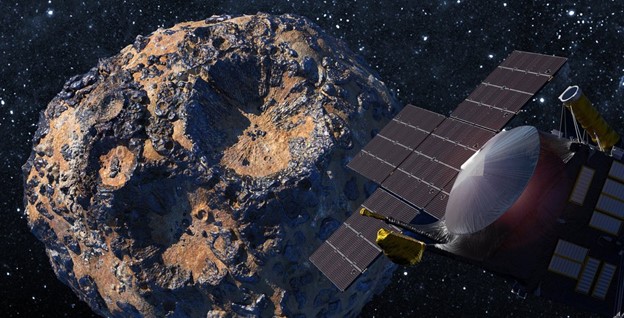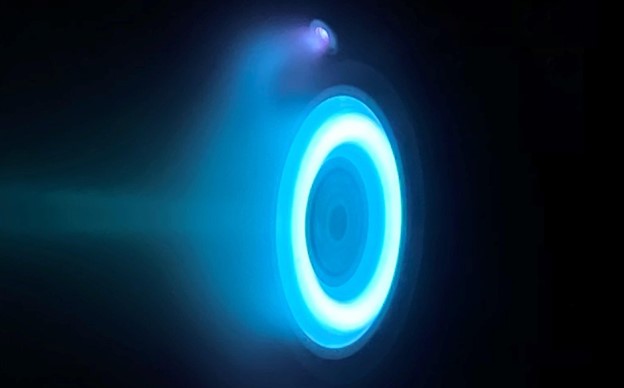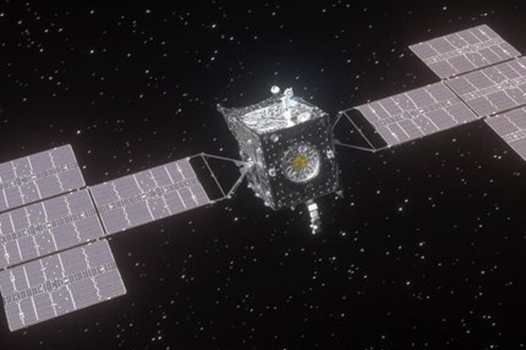
NASA’s deep-space mission to the Psyche asteroid involves a variety of cutting-edge magnetic technologies for precision measurement as well as electrified propulsion. The Psyche spacecraft includes many unavoidable magnetic field sources, which must be accounted for to measure the magnetic field signature of the metal-rich asteroid. It won’t be long now … hold on until 2029 when it reaches orbit at the distant target.
The visual at top illustrates the complex nature of the spacecraft’s magnetic field, modeled as the sum of over 200 individual sources arising from various spacecraft subsystems and instruments. Magnetic sources include hard magnets as well as current loops that generate variable magnetic fields in the two solar array wings which extend outward from the spacecraft. Magnetic field lines that originate from these sources are spatially color-coded by their strength, where red colors indicate higher field strengths and blue colors indicate lower strengths.
NASA scientists will measure the asteroid’s magnetic field using a magnetometer. The instrument is composed of two identical high-sensitivity magnetic field sensors located at the middle and outer end of a 6-foot boom. The boom extends from the top of the spacecraft to distance the measurements from the contaminating magnetic fields of the spacecraft.

The spacecraft will reach the asteroid in August 2029, orbiting it for 26 months to gain insights into planetary formation, better understand the interior of terrestrial planets like Earth, and examine a world that is made largely of metal.

Powered by Hall-effect thrusters, Psyche’s solar electric propulsion system system harnesses energy from large solar arrays to create electric and magnetic fields. These, in turn, accelerate and expel charged atoms, or ions, of a propellant called xenon (the neutral gas used in car headlights and plasma TVs) at such high speed, it creates thrust.
The plasma, or ionized gas, emits a sci-fi-like blue glow as it trails behind Psyche in space. Each of Psyche’s four thrusters, which will operate only one at a time, exert at most the same amount of force that one AA battery would exert on the palm of your hand. Over time, in the frictionless void of space, the spacecraft will slowly and continuously accelerate. Psyche’s propulsion system builds on similar technologies used by NASA previously, but it will be the agency’s first mission to use Hall-effect thrusters in deep space. To date, they have been used only by a European Space Agency mission to the Moon.

So far, the Psyche spacecraft is on a roll, NASA reported in December, eight weeks after it left earth on October 13. Already 16 million miles from Earth, it is on track to reach the asteroid Psyche in the main asteroid belt between Mars and Jupiter five years from now. The orbiter has performed one successful operation after another, powering on scientific instruments, streaming data toward home, and setting a deep-space record with its electric thrusters.
Early in the mission, in late October, the team powered on the magnetometer and, shortly after, it gave scientists an unexpected gift: It detected a solar eruption, a common occurrence called a coronal mass ejection, where the Sun expels large quantities of magnetized plasma. Since then, the team has seen several of these events and will continue to monitor space weather as the spacecraft travels to the asteroid.
The magnetometer is designed to provide crucial data to help determine how the asteroid formed. It will look for evidence of an ancient magnetic field. Since the asteroid was discovered in 1852, scientists have only been able to study this potato-shaped object from afar. Over the years, they have discerned that Psyche is an unusual object likely rich in metal, but many questions about its origin and composition remain. The Psyche mission will be the first to study this kind of planetary object up close.
Judging from data obtained by Earth-based radar and optical telescopes, scientists hypothesize that the asteroid Psyche could be part of the metal-rich interior of a planetesimal, a building block of a rocky planet. The rocky planets are Mercury, Venus, Mars, and our home planet, Earth. It could be that Psyche collided with other large bodies during its early formation and lost its outer rocky shell. Humans can’t bore a path to Earth’s metal core – or the cores of the other rocky planets – so visiting Psyche could provide a one-of-a-kind window into the history of violent collisions and accumulation of matter that created planets like our own.

Psyche is so unusual, it could also surprise scientists and suggest a different story of how solar system objects formed. While rocks on Mars, Venus, and Earth are flush with iron oxides, Psyche’s surface – at least when studied from afar – doesn’t seem to feature much of these chemical compounds. This suggests that Psyche’s history differs from standard stories of planetary formation.
Scientists are excited to visit Psyche up close for the first time so they can learn more about its origin. If the asteroid is leftover core material from a planetary building block, they look forward to learning how its history resembles and diverges from that of the rocky planets. And if scientists discover that Psyche is not an exposed core of an early planetary building block, it may prove to be an even rarer kind of primordial solar system object, one that’s never been seen before. One of the most exciting aspects of this mission, says NASA, is the possibility of the unexpected. For more info, see www.nasa.gov.



